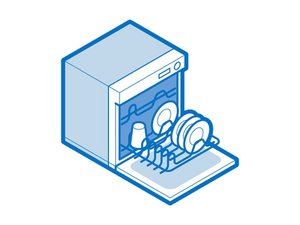Introduction
If your dishes are still dripping wet after a wash cycle, first check your dishwasher’s owner’s manual to make sure it’s being operated correctly. Many manufacturers recommend using a liquid rinse aid for proper drying performance. Additionally, if your home’s water temperature isn’t hot enough to begin with this can hinder drying performance—so adjust the temperature setting on your water heater if needed.
But if none of that helps, there may be an actual hardware issue with your dishwasher. In that case, check the following.
Causes
The vent fan blows the steamy air out of the aforementioned vent. If the vent door is opening properly but the fan motor has failed, most of the steamy air stays trapped in the dishwasher. Remove the fan motor and use a multimeter to test it for continuity. If there’s no continuity, replace the motor.

- 5 minutesEasy
The heating element lies inside your dishwasher near the bottom, and helps get the water hot enough to turn it into steam so the aforementioned fan can blow it out and leave everything inside nice and dry. If the heating element fails, the water never gets hot enough to evaporate.
To check the heating element, run a wash cycle using the heated dry feature, and open the dishwasher door in the middle of the dry cycle. (Watch out, it may be very hot in there.) It should be steamy hot inside, and if you wave your hand over the heating element (without touching anything!), you should be able to feel the heat coming off it.
If there’s no heat, you may need to replace the heating element—try removing it from the dishwasher and then use a multimeter to check the resistance of the heating element. It should measure somewhere in the range of 8-30 ohms. If resistance is infinite, replace the heating element.

- 5 minutesEasy
If the heating element checks out, you may have a heating element wiring failure, thermostat failure, limit switch failure, or control board failure.
Unplug the power to the dishwasher and shut off the water supply, disconnect the drain plug (remembering to use a drain pan), disconnect the water supply (use that pan again), and pull the dishwasher out from the wall. Disassemble the dishwasher enough to check the wiring connections to the heating element and make sure they’re tight.
Check the wiring to the thermostat in the same way. Remove the thermostat and test it with a multimeter—resistance should measure near zero ohms. If not, replace the thermostat.
Your dishwasher may also have a limit switch, which is a safety feature designed to switch off the heating element if it gets too hot. If the switch fails, the heating element may not turn on at all. Remove the switch and test it for continuity; if it fails, replace it.
If none of that helps, you may need to replace the electronic control board for the heating element.
You're seeing solutions for Dishwasher. Select your model to find parts for your device.








